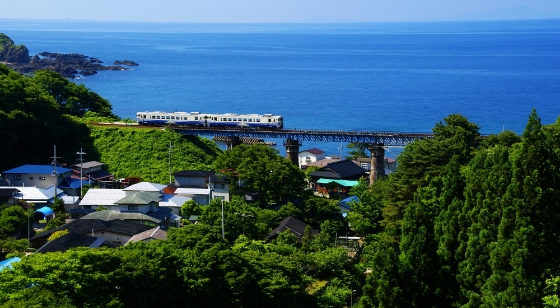I will show you some great sight in our town!
Contact: Happo Tourism Association http://www.happouta.jp/home/
Pears (nashi) have been cultivated in the Minehama district of the town of Happō for more than 100 years. Known for their excellent flavor and juiciness, Minehama nashi owe their distinctive taste to the area’s sandy coastal soil and the care-intensive methods used to grow them.
Minehama produces both European pears (yōnashi) and many varieties of Asian pears (yamanashi, usually just called nashi). Asian pears are the fruit of Pyrus pyrifolia, a tree native to East Asia. They are usually larger than their European counterparts and have a round shape similar to apples, but with a crisp texture all their own. The main varieties of Asian pear produced in Minehama are Kōsui, Hōsui, Akizuki, Chōjūrō, and Kaori; European pears are represented by the Flemish Beauty Himenkō variety. Each variety possesses a distinct flavor, ranging from the boldly sweet Akizuki to the light and fragrant Kaori.
In Japan, a fruit’s appearance is as important as its taste. Farmers take great care in cultivating each pear, performing nearly all the work by hand. In spring, tree blossoms are pollinated using a tufted wand that is dipped in a bag of crushed flowers and pollen. Once tiny pears appear on the branches, smaller or imperfect ones are trimmed away; this encourages the tree to direct more of its energy into the remaining fruit. Nashi skins bruise easily, so each growing pear is covered with a waxed bag to protect it from insects, disease, and weather damage. When the fruit is ripe, it is harvested by hand. In Minehama, the pear harvest occurs in September and October—a bit later than the rest of Japan due to the cooler weather.
To speed up the production of popular new varieties and to keep up with changing customer preferences, Minehama nashi farmers use a cultivation technique called grafting. A branch from the desired variety is carefully cut and placed against the cut limb of an older, well-rooted tree. The two are bound tightly together for a few months until they fuse and the branch is able to draw nourishment from the trunk. The benefits of grafting are considerable: instead of waiting years for a pear sapling to mature and bear fruit, farmers can have a new variety growing from an established tree within a year. Grafting also allows more delicate varieties to take advantage of the disease and weather resistance of older, sturdier trees. As a result of grafting, visitors to Minehama orchards will find two, three, or even four varieties of nashi growing on a single tree.
Some Minehama orchards offer pick-your-own nashi experiences, and will pack and ship the picked fruit domestically at a reasonable rate. Minehama nashi are also served in local restaurants, where they appear not only in desserts, but in savory dishes such as pasta and curry.


* This English-language text was created by the Japan Tourism Agency





